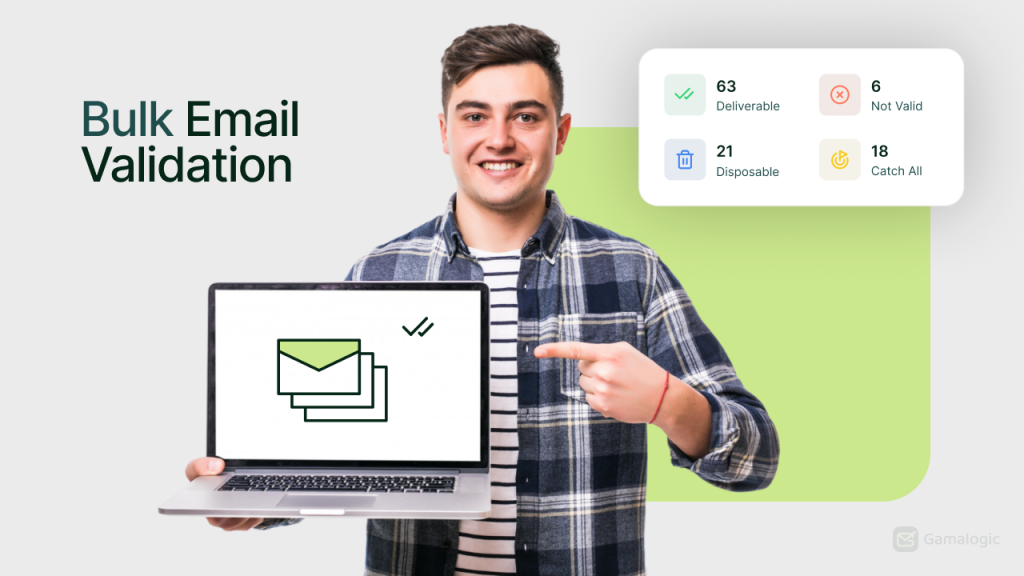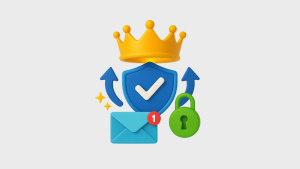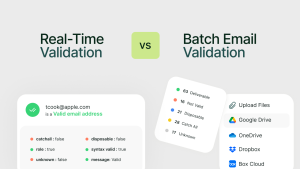- What Is an Email Validation API and Why It Matters
- Why Email Validation Matters for Businesses
- Core Features of a Successful Email Validation API
- How an Email Validation API Works
- Integration Guide for Developers
- Real-Time vs. Bulk Email Validation
- Best Practices for Using an Email Validation API
- Use Cases for Email Validation APIs
- How to Choose the Best Email Validation API
The email validation API is the backbone of reliable communication and successful email marketing. It ensures every email address in your database is real, active, and ready to receive messages — protecting your sender reputation and improving deliverability.
Email validation APIs help businesses and developers automatically verify email accuracy and deliverability in real time or in bulk. They check syntax, domain records, and mail servers, and even detect disposable or role-based addresses — ensuring your messages always reach real people, not invalid or temporary inboxes.
Because higher deliverability means stronger engagement, better sender reputation, and fewer wasted messages.
In simple terms, an email validation API connects your applications, CRM, Prospecting Automations or work flows, signup forms, or marketing tools to a service that validates email addresses before they enter your system. Whether you’re a SaaS platform, an ecommerce brand, or a developer managing user authentication, integrating a real-time email validation API helps you maintain clean data and improve performance across your campaigns.
This guide covers:
- Why email validation matters
- How email validation APIs work
- Core features every API should include
- Real-time vs. bulk email validation
- Integration steps and best practices
- Pricing and cost factors
- How to choose the right email validation API for your business

What Is an Email Validation API and Why It Matters
An email validation API is a powerful tool that automatically checks whether an email address is valid, deliverable, and safe to send messages to or simple say it is used for email validation.
It verifies email addresses in real-time or through batch processing using several key techniques, including:
- Syntax and format validation (ensures the address follows standard structure like user@domain.com)
- Domain and MX record checks (confirms the domain exists and can receive emails)
- SMTP and server validation (tests whether the mailbox is active)
- Disposable and temporary email detection (removes fake one-time emails)
- Role-based email filtering (flags emails like info@ or support@)
When used in sign-up forms, CRMs, or email campaigns, these checks prevent fake sign-ups, reduce bounce rates, and keep your lists healthy.
For more info: Learn How to Integrate an Email Validation API →
Why Email Validation Matters for Businesses
Imagine running a campaign to 10,000 email addresses — and 2,000 bounce. That’s 20% wasted effort, lost leads, and potential spam penalties.
An email validation service API eliminates these issues by verifying addresses before you send, ensuring better inbox placement and engagement.
Key Benefits:
- Improved Deliverability: Valid emails reach real users.
- Reduced Bounce Rate: No invalid or fake sign-ups.
- Protected Sender Reputation: Avoid blacklists and spam flags.
- Optimized Campaign ROI: Every email sent has value.
- Compliance & Data Hygiene: Maintain GDPR and privacy standards.
For more info:: Read More: Email Validation Accuracy and Metrics →
Core Features of a Successful Email Validation API
When comparing providers, the best email validation APIs for developers should offer:
1. Syntax & Format Validation
Checks if the email address structure follows RFC standards.
(Example: detecting typos like john@gmial.com)
2. Domain Verification
Verifies the existence of the domain and its MX records to ensure it can receive emails.
3. SMTP Verification
Connects to the mail server without sending a real email — confirming the mailbox is active.
4. Disposable Email Detection
Identifies temporary or one-time use emails from services like 10minutemail or Guerilla Mail.
5. Role-Based Email Detection
Flags addresses like admin@ or sales@ that may not represent a real person.
6. Real-Time and Bulk Validation
- Real-time validation: Checks during form submission or user signup.
- Bulk validation: Cleans entire lists before campaigns.
7. Ease of Integration
REST API with clear documentation, and sample code in popular languages (Python, Node.js, PHP).
8. Reporting & Analytics
Some advanced APIs provide validation scores, catch-all detection, and risk scoring.
How an Email Validation API Works
The process of validating an email through an API involves several layers:
- Syntax Check: Detect format errors.
- Domain Lookup: Confirm DNS and MX records exist.
- SMTP Ping: Verify if the mailbox can accept mail.
- Blacklist & Disposable Check: Filter out risky addresses.
- Response Return: The API sends a JSON result like:
{
"gamalogic_emailid_vrfy": [
{
"do_you_mean": false,
"emailid": "user@microsoft.com",
"is_catchall": false,
"is_disposable": false,
"is_role": false,
"is_syntax_valid": true,
"is_unknown": false,
"is_valid": false,
"message": "Not Valid ID",
"resolved_time": 1.8817
}
]
}Developers can use these results to accept or reject addresses instantly, improving data quality in real-time.
Integration Guide for Developers
Integrating an email address validation API is straightforward:

1. Get API Access
Sign up on your chosen platform (like Gamalogic). Generate your API key.
2. Make Validation Requests
Here’s a simple Python example:
import requests
api_key = "your_api_key"
email = "test@example.com"
url = f"https://gamalogic.com/emailvrf?emailid={email}&apikey={api_key}"
response = requests.get(url)
if response.status_code == 200:
print(response.json())3. Handle Responses & Errors
Implement error handling, secure storage for API keys, and retry logic for timeouts.
For more info: See Full Integration Tutorial for Developers →
Pricing and Cost Considerations
Email validation APIs are priced based on request volume and depth of validation.
Common pricing models include:
- Free email validation API tiers — great for testing.
- Pay-as-you-go — flexible for small to medium projects.
- Subscription plans — suitable for ongoing, large-scale use.
When evaluating, consider:
- Accuracy level and speed
- API uptime guarantee (SLA)
- Rate limits and concurrency
- Support and documentation quality
For more info : See: Pricing Models for Email Validation APIs →
Real-Time vs. Bulk Email Validation
Real-Time Validation
Perfect for registration forms, lead capture, and web applications.
Instantly detects invalid or fake emails during input.
For more info, read more: Real-Time Email Verification: How to Validate Email Addresses Instantly →
Bulk Validation

Ideal for cleaning existing email databases before a marketing campaign.
Helps remove outdated or inactive contacts at scale.
It ensures your campaigns reach active inboxes, improving open and click rates.
Bulk validation is especially useful before seasonal promotions or re-engagement emails.
By cleaning your list in batches, you maintain high sender reputation and avoid spam traps.
Both methods can be used together for maximum effectiveness.
For more info, read more: ( Real-Time vs. Bulk Email Validation → )
Best Practices for Using an Email Validation API
- Validate Lists Regularly:
Run batch checks before major campaigns. - Monitor API Usage & Logs:
Keep track of success rates, response times, and accuracy. - Secure Your API Keys:
Store credentials safely and rotate periodically. - Automate Everything:
Schedule automatic validation workflows for new sign-ups and uploads.
For more info Read More: How to Improve Deliverability with Email Validation →
Use Cases for Email Validation APIs
Email validation APIs have broad use cases. It was used by millions of email marketers and developers.
- Prevent Fake Signups: Block bots and spammers.
- Enhance CRM Hygiene: Keep only verified contacts.
- Improve Marketing ROI: Ensure every email hits the inbox.
- Reduce Customer Support Overload: Stop bounce-related complaints.
- Boost Transactional Emails: Password resets, confirmations, and alerts always reach users.
How to Choose the Best Email Validation API
When selecting a provider, consider:
- Accuracy & Speed: Quick Real time email validation
- Documentation Quality: Developer-friendly with documentation and examples.
- Scalability: Handles real-time and batch requests simultaneously.
- Integration Options: REST, JSON, or webhook support.
- Customer Support: 24/7 help and troubleshooting.
- Free Trials: Start with a free email validation API to test results.
Pro Tip: Gamalogic offers both real-time email validation API and bulk email validation API, designed for high-speed accuracy and easy integration with CRMs, ESPs, and marketing tools.
Conclusion
Email validation isn’t just a technical process — it’s the foundation of trustworthy communication.
A reliable email validation API ensures every message you send reaches a real, engaged recipient.
Whether you’re a marketer aiming for higher inbox placement or a developer improving data accuracy, using a validation API helps protect your sender reputation, reduce bounce rates, and enhance campaign ROI.
Start verifying your emails today with Gamalogic’s Real-Time Email Validation API.
Clean lists, accurate data, and better deliverability — all with one simple API.
Further Reading
You might also like

Dominate Deliverability: Pro Email Validation Hacks and Strategies
Dominate deliverability with proven email validation hacks and strategies that keep your campaigns out of spam folders and in front of the right audience. Discover how to clean your lists, boost sender reputation, and ensure every email hits the inbox.

Real-Time vs Batch Email Validation: When to Use Each
Real-Time vs Batch Email Validation: When to Use Each? In this guide, we’ll break down the difference between real-time and batch (bulk) email validation






 No credit card required
No credit card required



Post your Comment.